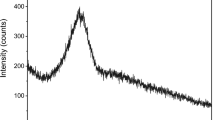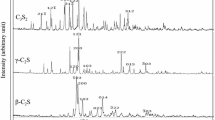Abstract
Cement production causes serious environmental problems and requires large amounts of energy. Studies have proven that the use of geopolymers can significantly reduce carbon dioxide emission and energy consumption arisen from cement production. Although there are many studies on the geopolymers, the number of studies dealing with geopolymers containing natural pozzolans other than metakaolin is very limited. In this study, the compressive strength and pore structure of geopolymers produced with trass (a type of natural pozzolan) were investigated. The mineralogical composition of trass, morphology of trass, and microstructure of geopolymer paste as well as the weight loss of the paste were determined using XRD, SEM, and TGA examinations, respectively. Moreover, the pore size distribution of the paste mixtures was obtained with Micro-CT analysis. The trass was used both in the natural form and after calcining at 550 °C for 6 h. The strength of geopolymer mortars produced with calcined trass, cured at 90 °C for 24 and 96 h, was found to be 86.7% and 81.6% higher than that of their counterparts containing natural trass. In addition, calcination of the trass resulted in 12.8–22.9% reduction in the porosity of geopolymer paste, compared to that of the paste containing natural trass. In XRD and TGA investigations, it was determined that the trass calcination performed at 550 °C did not make a significant change in the paste crystal structure and the weight loss-temperature graphs. SEM images proved that the reactivity of trass in geopolymerization increased with calcination and the matrix structure became denser and more homogeneous.









Similar content being viewed by others
References
Sikandar, M.A., Jo, B.W., Baloch, Z., Khan, M.A.: Properties of chemically synthesized nano-geopolymer cement based self-compacting geopolymer concrete (SCGC). J. Wuhan. Univ. Technol. Mater. Sci. Ed. 34(1), 98–106 (2021). https://doi.org/10.1007/s11595-019-2021-2
Vikas, G., Rao, T.D.G.: Setting time, workability and strength properties of alkali activated fly ash and slag based geopolymer concrete activated with high silica modulus water glass. IJST-T CIV Eng. 45, 1483–1492 (2021). https://doi.org/10.1007/s40996-021-00598-8
Ganesh, A.C., Muthukannan, M.: Development of high performance sustainable optimized fiber reinforced geopolymer concrete and prediction of compressive strength. J. Clean. Prod. (2021). https://doi.org/10.1016/j.jclepro.2020.124543
International Enery Agency: Cement reports. https://www.iea.org/reports/cement. (2021) Accessed 1 January 2022
Gulsan, M.E., Alzeebaree, R., Rasheed, A.A., Nis, A., Kurtoglu, A.E.: Development of fly ash/slag based self-compacting geopolymer concrete using nano-silica and steel fiber. Constr. Build Mater. 211, 271–283 (2019). https://doi.org/10.1016/j.conbuildmat.2019.03.228
Duxson, P., Provis, J.L., Lukey, G.C., van Deventer, J.S.J.: The role of inorganic polymer technology in the development of ‘green concrete.’ Cem. Concr. Res. 37, 1590–1597 (2007). https://doi.org/10.1016/j.cemconres.2007.08.018
Davidovits, J.: Geopolymer cement: a review. Geopolymer Science and Technics, Technical Paper. 21, 1–11 (2013)
Prabha, V.C., Revathi, V., Reddy, S.S.: Ambient cured high calcium fly ash geopolymer concrete with dolomite powder. Eur. J. Environ. Civ (2021). https://doi.org/10.1080/19648189.2021.2012262
Irshidat, M.R., Abdel-Jawad, Y.A., Al-Sughayer, R.: Feasibility of producing sustainable geopolymer composites made of locally available natural pozzolans. J. Mater. Cycles Waste Manag. 20, 1751–1760 (2018). https://doi.org/10.1007/s10163-018-0742-5
Metekong, J.V.S., Kaze, C.R., Adesina, A., Nemaleu, J.G.D., Djobo, J.N.Y., Lemougna, P.N., Alomayri, T., Kamseu, E., Melo, U.C., Tatietse, T.T.: Influence of thermal activation and silica modulus on the properties of clayey-lateritic based geopolymer binders cured at room temperature. Silicon (2022). https://doi.org/10.1007/s12633-021-01566-7
Thokchom, S., Ghosh, P., Ghosh, S.: Effect of Na2O content on durability of geopolymer mortars in sulphuric acid. Int. Scholarly Sci. Res. Innov. 3(3), 193–198 (2009). https://doi.org/10.5281/zenodo.1334099
Salahuddin, M.B.M., Norkhairunnisa, M., Mustapha, F.: A review on thermophysical evaluation of alkali-activated geopolymers. Ceram. 41, 4273–4281 (2015). https://doi.org/10.1016/j.ceramint.2014.11.119
Firdous, R., Stephan, D.: Impact of the mineralogical composition of natural pozzolans on properties of resultant geopolymers. J. Sustain. Cem.-Based. Mater. 10(3), 149–164 (2021). https://doi.org/10.1080/21650373.2020.1809028
Robayo-Salazar, R.A., de Gutierrez, R.M.: Natural volcanic pozzolans as an available raw material for alkali-activated materials in the foreseeable future: a review. Constr Build Mater. 189, 109–118 (2018). https://doi.org/10.1016/j.conbuildmat.2018.08.174
Singh, N.B.: Fly ash-based geopolymer binder: a future construction material. Minerals (2018). https://doi.org/10.3390/min8070299
Hollanders, S.: Mineralogical study of the pozzolanic properties of calcined clays. Ph.D. Thesis. KU Leuven, Science, Engineering & Technology, Arenberg Doctoral School Faculty of Science (2017). Heverlee, Belgium.
Ghani, U., Hussain, S., Amin, N., Imtiaz, M., Khan, S.A.: Role of calcination on geopolymerization of lateritic clay by alkali treatment. J. Saudi Chem. Soc (2021). https://doi.org/10.1016/j.jscs.2021.101198
Nikolov, A., Rostovsky, I., Nugteren, H.: Natural and calcined zeolite (metazeolite) based geopolymers. Bulgarian Geological Society-Geosciences. 31–32 (2017)
Antoni, A., Geman, R., Tjondro, R.T., Anggono, J., Hardjito, D.: Effects of calcination temperature of Lusi mud on the compressive strength of geopolymer mortar. Adv. Mat. Res. 626, 224–228 (2013). https://doi.org/10.4028/www.scientific.net/AMR.626.224
Bascik, H.I.: Development of calcined natural pozzolan-based geopolymer mortar, Master Thesis, Ege University Graduate School of Natural and Applied Science Izmir. Turkey (2019)
ASTM C311/C311M-18: Standard test methods for sampling and testing fly ash or natural pozzolans for use in portland-cement concrete (2018). PA, USA.
TS EN 196–1: Methods of testing cement - part 1: determination of strength, Ankara, Turkey, 2016.
Hardjito, D., Wallah, S.E., Sumajouw, D.M.J., Rangan, B.V.: Geopolymer concrete: turn waste into environmentally friendly concrete. International Conference on Recent Trends in Concrete Technology and Structures, Incontest (2003). Coimbatore, India
Chithambaram, S.J., Kumar, S., Prased, M.M.: Thermo-mechanical characteristics of geopolymer mortar. Constr. Build Mater. 213, 100–108 (2019). https://doi.org/10.1016/j.conbuildmat.2019.04.051
Bing-hui, M., Zhu, H., Xue-min, C., Yan, H., Si-yu, G.: Effect of curing temperature on geopolymerization of metakaolin-based geopolymers. Appl. Clay Sci. 99, 144–148 (2014). https://doi.org/10.1016/j.clay.2014.06.024
Firdous, R., Stephan, D.: Effect of silica modulus on the geopolymerization activity of natural pozzolans. Constr. Build Mater. 219, 31–43 (2019). https://doi.org/10.1016/j.conbuildmat.2019.05.161
Acknowledgements
This work was supported by the Ege University Scientific Research Projects Coordination under grant number of 17-MUH-029. The authors also acknowledge the contribution of Ege University Central Research, Test and Analysis Laboratory for SEM, TG and Micro-CT analysis as well as Izmir Katip Celebi University Central Research Laboratory for XRD and particle size distribution determination.
Author information
Authors and Affiliations
Contributions
Conceptualization: Adil Gultekin, Semsi Yazici, Kambiz Ramyar; methodology: Adil Gultekin, Semsi Yazici, Kambiz Ramyar; investigation: Adil Gultekin, Kambiz Ramyar; writing—original draft preparation: Adil Gultekin; writing—review and editing: Kambiz Ramyar.
Corresponding author
Ethics declarations
Competing interests
The authors declare no competing interests.
Additional information
Publisher's note
Springer Nature remains neutral with regard to jurisdictional claims in published maps and institutional affiliations.
Rights and permissions
Springer Nature or its licensor holds exclusive rights to this article under a publishing agreement with the author(s) or other rightsholder(s); author self-archiving of the accepted manuscript version of this article is solely governed by the terms of such publishing agreement and applicable law.
About this article
Cite this article
Gultekin, A., Yazici, S. & Ramyar, K. Effect of trass calcination on properties of geopolymer mixtures. J Aust Ceram Soc 58, 1623–1631 (2022). https://doi.org/10.1007/s41779-022-00799-y
Received:
Revised:
Accepted:
Published:
Issue Date:
DOI: https://doi.org/10.1007/s41779-022-00799-y




